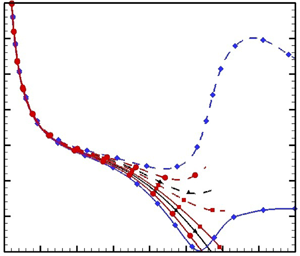Article contents
Elevated low-frequency free-stream vortical disturbances eliminate boundary-layer separation
Published online by Cambridge University Press: 08 June 2021
Abstract

A steady two-dimensional boundary layer subject to an adverse streamwise pressure gradient usually separates. In this paper, we investigate how free-stream vortical disturbances (FSVD) of moderate level prevent the separation in such a boundary layer over a plate or concave wall. The focus is on physically realisable FSVD with sufficiently long wavelength (low frequency) as they have the most significant impact on the boundary layer. The FSVD intensity  $\epsilon$ is taken to be small but nevertheless strong enough that the streaks or Görtler vortices generated in the boundary layer are fully nonlinear and can alter the mean-flow profile by an order-one amount. The excitation and evolution of streaks and Görtler vortices are governed by the nonlinear unsteady boundary-region equations supplemented by appropriate initial (upstream) and boundary (far-field) conditions, which describe appropriately the action of FSVD on the boundary layer. The flow variables are decomposed into two parts: the steady spanwise-averaged and the unsteady or spanwise-varying components. These two parts are coupled and are computed simultaneously. Numerical results show that the separation is eliminated when the FSVD level exceeds a critical intensity
$\epsilon$ is taken to be small but nevertheless strong enough that the streaks or Görtler vortices generated in the boundary layer are fully nonlinear and can alter the mean-flow profile by an order-one amount. The excitation and evolution of streaks and Görtler vortices are governed by the nonlinear unsteady boundary-region equations supplemented by appropriate initial (upstream) and boundary (far-field) conditions, which describe appropriately the action of FSVD on the boundary layer. The flow variables are decomposed into two parts: the steady spanwise-averaged and the unsteady or spanwise-varying components. These two parts are coupled and are computed simultaneously. Numerical results show that the separation is eliminated when the FSVD level exceeds a critical intensity  $\epsilon _c$. It is inferred that the strong nonlinear mean-flow distortion associated with the nonlinear streaks or Görtler vortices prevents the separation. The critical FSVD intensity
$\epsilon _c$. It is inferred that the strong nonlinear mean-flow distortion associated with the nonlinear streaks or Görtler vortices prevents the separation. The critical FSVD intensity  $\epsilon _c$ depends on the streamwise curvature, the pressure gradient and the frequency of FSVD. The value of
$\epsilon _c$ depends on the streamwise curvature, the pressure gradient and the frequency of FSVD. The value of  $\epsilon _c$ decreases significantly with the Görtler number, indicating that concave curvature inhibits separation. A higher
$\epsilon _c$ decreases significantly with the Görtler number, indicating that concave curvature inhibits separation. A higher  $\epsilon _c$ is required to prevent the separation in the case of stronger adverse pressure gradient. Interestingly, unsteady FSVD with low frequencies are found to be more effective than steady ones in suppressing the separation.
$\epsilon _c$ is required to prevent the separation in the case of stronger adverse pressure gradient. Interestingly, unsteady FSVD with low frequencies are found to be more effective than steady ones in suppressing the separation.
Information
- Type
- JFM Papers
- Information
- Copyright
- © The Author(s), 2021. Published by Cambridge University Press
References
REFERENCES
- 6
- Cited by


